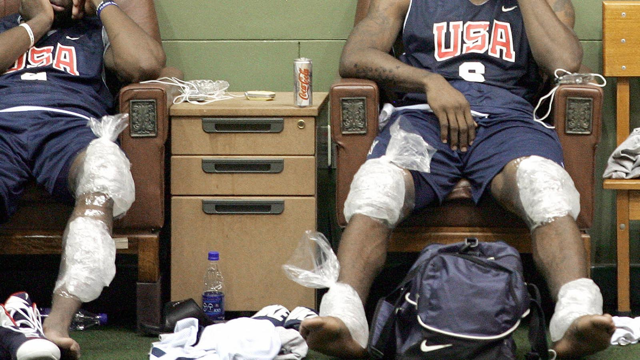
To ice or not to ice? The role of cold in injury and performance
In the pursuit of peak physical performance, athletes and exercise enthusiasts often explore various strategies to enhance recovery and minimise the impact of injuries. One such approach that has gained popularity is cryotherapy, a method involving the application of cold temperatures to the body.
As we delve into the realm of cryotherapy and its effects on metabolism and inflammation, it becomes crucial to dissect the mechanisms behind injuries, understand the natural recovery process, and scrutinise the scientific and traditional perspectives on cryotherapy’s efficacy.
In this exploration, we aim to demystify the interplay between cryotherapy interventions and the body’s response to injury and exercise. From traditional practices rooted in the RICE (Rest, Ice, Compress, Elevate) protocol to modern methods like whole-body cryotherapy, we navigate through the diverse landscape of methods.
Sit back and enjoy the science behind icing injuries
Check out more research break downs – HERE
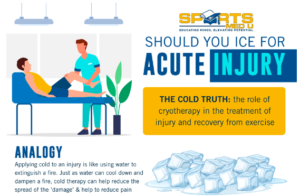
What causes injuries ?
In the realm of physiotherapy and sports medicine, understanding the mechanisms behind “injuries” is paramount. From direct insults such as blunt trauma (rugby tackle) to structural muscle damage caused by excessive mechanical stress during eccentric contractions (gym workout), the complexities of injury aetiology are multifaceted.
Prolonged and intense exercises, like marathon running, introduce metabolic stress, leaving muscle fibers vulnerable to subsequent mechanical stress. The rise in temperature during exercise indirectly contributes to structural damage by altering the cell environment and increasing metabolic rate.
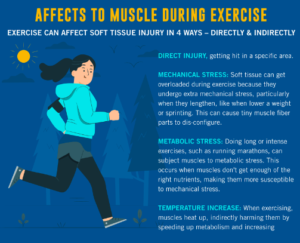
Diverse Cryotherapy Methods: Convenience and Controversy
Athletic training centers, spas, and homes commonly offer various cooling methods, from whole-body cryotherapy and cold-water immersion to placing a cold pack on your knee. These methods provide different levels of convenience and cost, catering to diverse population. However, ongoing research on the molecular response to icing shows inconsistent and inconclusive evidence, increasing the controversy surrounding the effectiveness of these treatments for both injuries and exercise recovery.
In the dynamic landscape of injury management, physiotherapists and sports medicine practitioners find themselves at the intersection of tradition and evolving scientific understanding.
The Natural Recovery Process and The Role of Ice
Post-exercise, muscle fibers initiate a natural recovery process, aiming to return to their pre-exercise state. The extent of this recovery hinges on the level of activity and metabolic stress on the cell. Cryotherapy emerges as a potential ally during the secondary stage of cellular response, working to mitigate initial damage and quicken the recovery process.
The traditional RICE (Rest, Ice, Compression, Elevation) protocol, deeply ingrained in injury management practices, faces a paradox. Despite its widespread use, scientific evidence supporting its efficacy remains limited. Recent literature and popular social media creators even discourage the routine use of ice, advocating for the body’s natural healing response.
This has sparked lively debates among clinicians, challenging the conventional approach to injury treatment.
But what is is actually the right thing to do?
The effects of cryotherapy on metabolism and inflammation
Let’s break this down.
Cryotherapy, which involves cooling down of an area, has this ancient reputation of slowing down metabolism and curbing inflammation after an ‘injury’. The idea is that by reducing the temperature and blood flow at the injury spot, it puts a lid on the body’s need for energy and calms down the inflammation.
But, what does the the science say?
Most of our cryotherapy wisdom comes from studying animals. Yep, we’re talking about rodents, not humans. This throws a spanner in the mix as mouse/rat muscles are quite different from human muscles when it comes to how they use energy and react to the environment.
When scientists try to apply what they’ve learned from these animal studies to humans, it gets a bit tricky. Cryotherapy has been widely used after injuries or workouts, with the hope that it will lower metabolism and tone down inflammation, as shown in the animal studies .
However, these affects have not been shown in people.
How does cryotherapy actually work?
In the past, people believed that cryotherapy worked by making blood vessels respond to the cold, which reduced muscle blood flow, lowering muscle metabolism, inflammation, and damage.
Recent research indicates that cryotherapy’s effectiveness in recovery mainly comes from lowering muscle temperature rather than affecting blood flow.
Injuries to muscles and joints usually cause damage in a specific area and don’t necessarily raise the body’s overall temperature.
For recovery after intense exercise, cryotherapy methods that create changes throughout the body are more effective. However, for less intense activities, applying cold locally with ice may be enough for recovery.
It’s important to note that the impact of cryotherapy can vary across different layers of tissue (skin, fat, superficial, deep muscle), which is often overlooked by healthcare professionals and athletes. Skin and superficial tissues reach lower temperatures than deep muscles during cryotherapy, affecting overall muscle recovery.
Since muscles don’t have thermal receptors, the skin triggers temperature responses in muscles. Deep muscle tissue loses heat mainly to superficial muscle tissue during skin cooling.
While gel packs may be colder initially and reduce skin temperature faster than ice or frozen peas, solely reducing skin temperature without affecting deep muscle temperature may not lead to significant changes in muscle metabolism or inflammation and could even result in cold-related injuries.
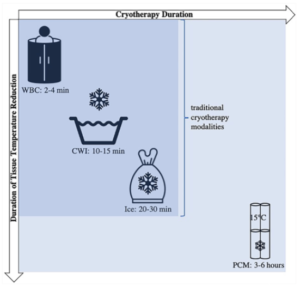
What are the ice methods used for injury and recovery?
Ice packs
Ice packs are a common approach for treating and assisting recovery from various injuries like strains, sprains and contusions
Traditionally, applying ice immediately after an injury helps relieve pain by slowing down nerve signals.
When used for managing early soft tissue injuries or post-surgery, ice could potentially improve outcomes by reducing bleeding and secondary cell damage, but it needs to be administered promptly after the injury occurs (First 24 hours).
However, there isn’t clear evidence from controlled trials supporting the use of cryotherapy to speed up recovery. A recent analysis found that using ice locally doesn’t reduce soreness or quicken strength recovery after exercise.
Cryotherapy Chambers
Whole-body cryotherapy, where you’re briefly exposed to extremely cold air (−110 °C to −140 °C), has become popular for recovery after intense training and competition. Various reviews have explored its impacts on physiology, neuromuscular responses, and perception to speed up post-exercise recovery.
Studies suggest that whole-body cryotherapy can effectively improve the perceived recovery from soreness after exercise. Which can play a big role in athletes confidence and well being.
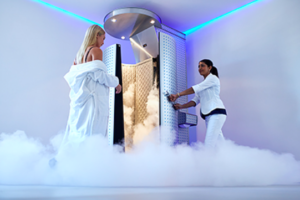
Full body cold water immersion
Meta-analyses indicate that cold-water immersion provides some benefits in reducing soreness for up to 96 hours after exercise. There’s also evidence supporting the use of cold-water immersion in lowering blood markers linked to muscle damage.
Differences in outcomes across studies may be due to variations in the temperature and duration of cold-water immersion protocols.
Some researchers argue that cryotherapy, especially ice, might hinder inflammation, potentially affecting tissue repair and collagen synthesis. However, this argument is based solely on evidence from animal models
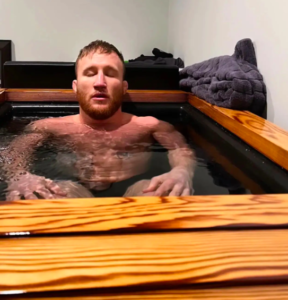
What are the negative effects from cryotherapy?
After injury or intense exercise, inflammation serves both positive and negative roles, contributing to secondary tissue damage while also aiding in the repair and restoration of affected tissues.
Recent literature on animals suggests being mindful of using ice frequently to avoid potential setbacks in the regeneration process and the body’s natural healing response post-injury and exercise.
It’s important to note that conclusive evidence for similar negative effects on the healing process in humans hasn’t been firmly established.
Muscle mass & recovery post workouts
Observations indicate that cryotherapy, particularly cold water immersion, may have adverse effects on muscle mass and strength gains. Regular use in post-exercise routines can impede muscle protein synthesis rates due to cryotherapy-induced reductions in intramuscular temperature, hindering the anabolic response that is triggered by glutamine.
While there’s evidence supporting the detrimental effects of cryotherapy in long term adaptation, using cryotherapy early for six consecutive hours doesn’t seem to interfere with the naturally occurring adaptive mechanism known as the repeated bout effect.
Following an initial bout of exercise, there’s minimal change in intramuscular inflammation markers. However, a second bout results in significant increases in various pro-inflammatory cytokines, along with notable macrophage and T-cell infiltration.
These findings suggest that repeated use of cold water immersion over time may hinder recovery after traditional resistance training. Nevertheless, a single cooling treatment following one exercise bout doesn’t compromise the adaptation that protects against damage in workouts that follow after.
When should you use ice after injury?
- In season, athletes should primarily use cryotherapy not to enhance muscle growth but to speed up recovery and prevent muscle breakdown after intense workouts.
- In situations where athletes have back-to-back games or a night game followed by a morning practice, quick recovery becomes more important than focusing on muscle growth.
- Immediate Use: Apply cryotherapy right after an injury or workout to effectively reduce swelling and manage pain.
- Timing: Research suggests that exposing the affected area to cold for 15-25 minutes, 2 or 3 times a day after an injury, can help reduce pain levels and potentially shorten recovery time.
- Full-body Cold Immersion Right After Exercise: Generally, this isn’t recommended because it might dull the body’s hormonal and cellular responses to the workout. However, if an athlete has an upcoming competition and wants to feel as refreshed as possible, it might be considered.
- Reducing Muscle Soreness with Cold Immersion: For athletes in-season preparing for a competition or match within 24 to 72 hours, cold immersion can help alleviate soreness. But it’s not recommended if the goal is to boost performance, as mentioned earlier.

Final Thoughts
In the dynamic landscape of injury management the debate surrounding the effectiveness of cryotherapy interventions continues to evolve, prompting critical evaluation and thoughtful consideration.
Concluding our deeper look into the study by Kwiecien and colleagues which explored the effects of cryotherapy on metabolism and inflammation, it is evident that the application of cold temperatures to the body is nuanced. The jury remains out on its true impact, and while cryotherapy holds promise in certain scenarios, careful consideration of individual needs and circumstances is important.
Whether seeking relief from soreness, aiming to quicken recovery after intense exercise, or navigating the complexities of injury treatment, individuals and practitioners must weigh the convenience and controversy surrounding cryotherapy methods. As the scientific community delves deeper into understanding the molecular responses to cryotherapy, the evolving landscape of sports medicine calls for a balanced integration of tradition and evidence-based practices to optimise the well-being of athletes and active individuals.
Credit
- Bleakley, C.M., Bieuzen, F., Davison, G.W. and Costello, J.T., 2014. Whole-body cryotherapy: empirical evidence and theoretical perspectives. Open access journal of sports medicine, pp.25-36.
- Dubois, B. and Esculier, J.F., 2019. Soft-tissue injuries simply need PEACE and LOVE. British journal of sports medicine, pp.bjsports-2019.
- Hausswirth, C., Louis, J., Bieuzen, F., Pournot, H., Fournier, J., Filliard, J.R. and Brisswalter, J., 2011. Effects of whole-body cryotherapy vs. far-infrared vs. passive modalities on recovery from exercise-induced muscle damage in highly-trained runners. PloS one, 6(12), p.e27749.
- Kalliokoski, K.K., Kirjavainen, A., Kemppainen, J., Di Salvo, V., Weston, M. and Cable, T., 2020. Changes in quadriceps femoris muscle perfusion following different degrees of cold-water immersion. Journal of Applied Physiology, 128(5), pp.1392-1401.
- Kwiecien, S.Y. and McHugh, M.P., 2021. The cold truth: the role of cryotherapy in the treatment of injury and recovery from exercise. European journal of applied physiology, 121(8), pp.2125-2142.
- Puntel, G.O., Carvalho, N.R., Dobrachinski, F., Salgueiro, A.C., Puntel, R.L., Folmer, V., Barbosa, N.B., Royes, L.F., Rocha, J.B.T. and Soares, F.A., 2013. Cryotherapy reduces skeletal muscle damage after ischemia/reperfusion in rats. Journal of anatomy, 222(2), pp.223-230.Mawhinney, C., Heinonen, I., Low, D.A., Han, C., Jones, H.,
- Versey, N.G., Halson, S.L. and Dawson, B.T., 2013. Water immersion recovery for athletes: effect on exercise performance and practical recommendations. Sports medicine, 43, pp.1101-1130



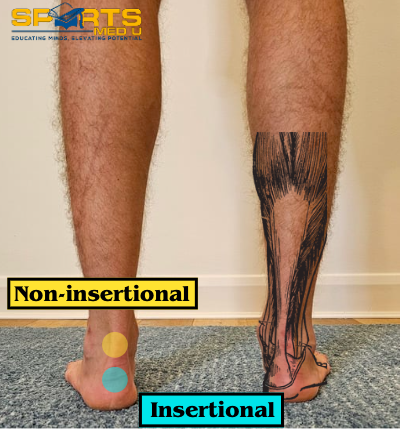
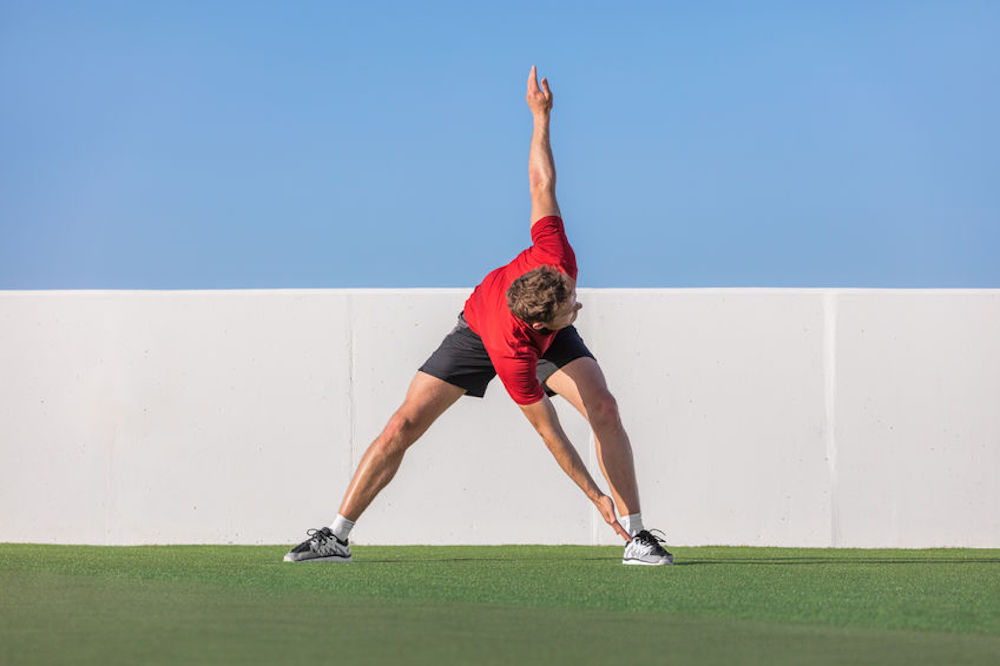
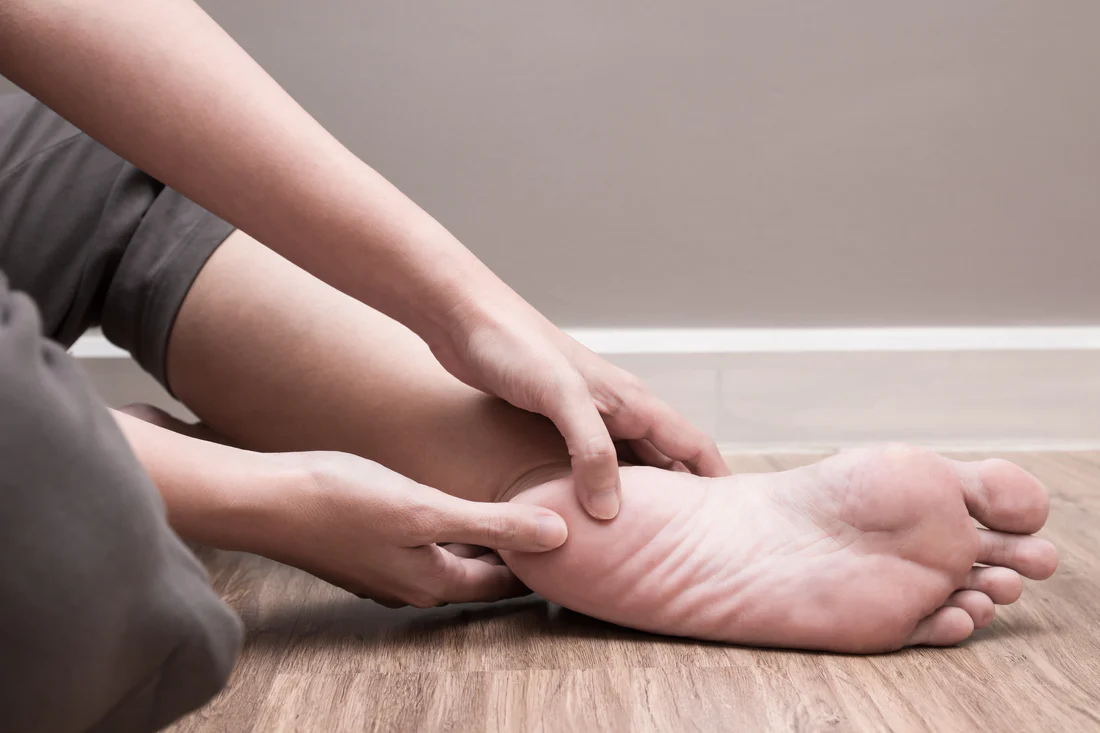
Leave a Reply